【精品】PPT课件 基本句型汉译英练习 主谓结构(S十V)
- 格式:ppt
- 大小:2.00 MB
- 文档页数:37
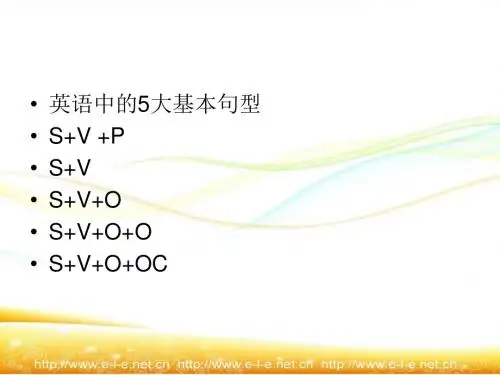
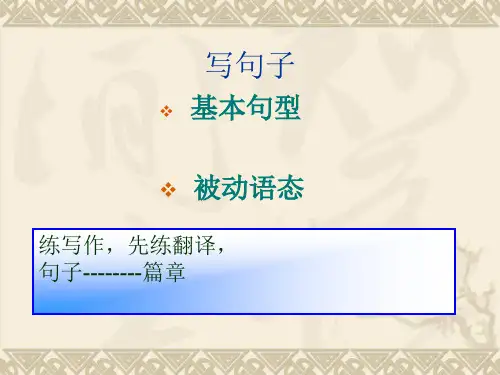


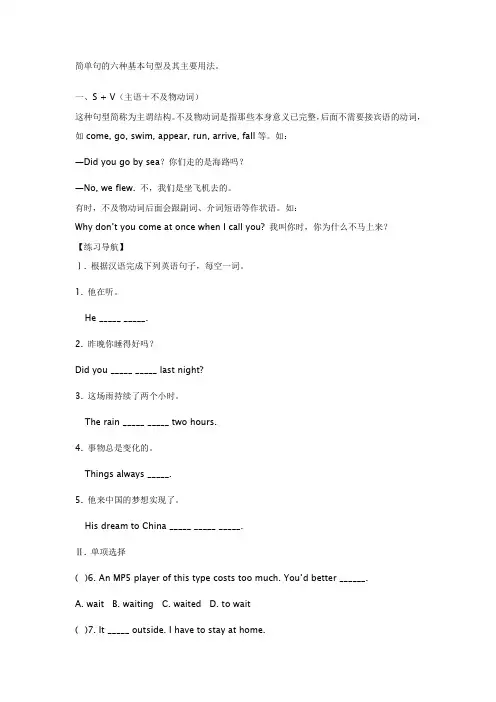
简单句的六种基本句型及其主要用法。
一、S + V(主语+不及物动词)这种句型简称为主谓结构。
不及物动词是指那些本身意义已完整,后面不需要接宾语的动词,如come, go, swim, appear, run, arrive, fall等。
如:—Did you go by sea?你们走的是海路吗?—No, we flew. 不,我们是坐飞机去的。
有时,不及物动词后面会跟副词、介词短语等作状语。
如:Why don’t you come at once when I call you? 我叫你时,你为什么不马上来?【练习导航】Ⅰ. 根据汉语完成下列英语句子,每空一词。
1. 他在听。
He _____ _____.2. 昨晚你睡得好吗?Did you _____ _____ last night?3. 这场雨持续了两个小时。
The rain _____ _____ two hours.4. 事物总是变化的。
Things always _____.5. 他来中国的梦想实现了。
His dream to China _____ _____ _____.Ⅱ. 单项选择( )6. An MP5 player of this type costs too much. You’d better ______.A. waitB. waitingC. waitedD. to wait( )7. It _____ outside. I have to stay at home.A. rainB. is rainingC. rainedD. has rained( )8. —Did you watch the basketball match yesterday?—Yes, I did. My uncle ______ in the match.A. is playingB. was playingC. has playedD. will play( )9. —What did your father say just now?—Sorry, I don’t know. I ______ on the phone.A. am talkingB. talkC. was talkingD. have talked( )10. You ______ first and I ______ behind.A. go; was followingB. will go; followC. will go; followedD. go; will follow二、S + V + P(主语+系动词+表语)系动词通常与表语一起构成系表结构,用来说明主语的性质、特点或状态等。
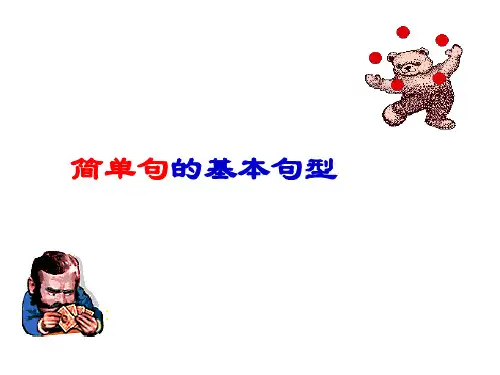
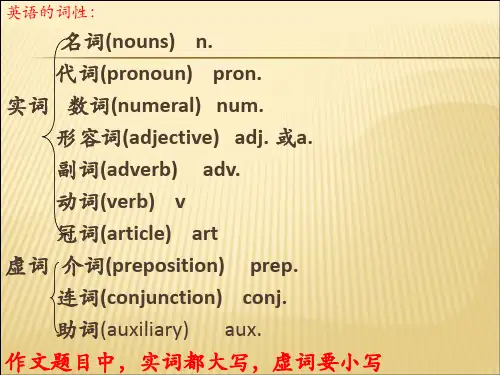
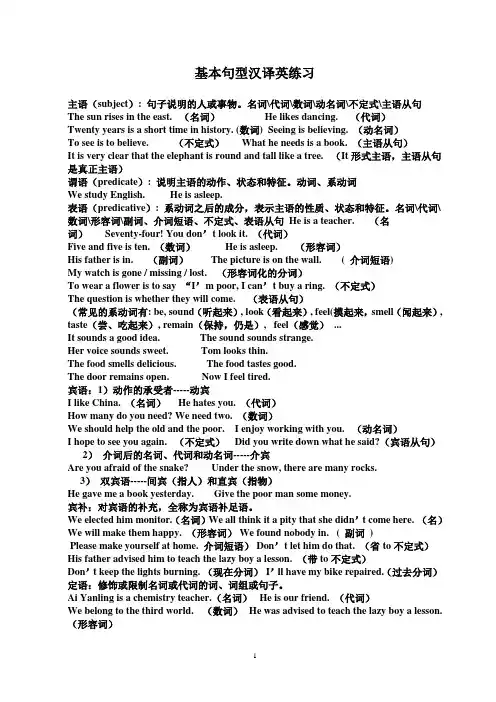
基本句型汉译英练习主语(subject): 句子说明的人或事物。
名词\代词\数词\动名词\不定式\主语从句The sun rises in the east. (名词)He likes dancing. (代词)Twenty years is a short time in history. (数词) Seeing is believing. (动名词)To see is to believe. (不定式)What he needs is a book. (主语从句)It is very clear that the elephant is round and tall like a tree. (It形式主语,主语从句是真正主语)谓语(predicate): 说明主语的动作、状态和特征。
动词、系动词We study English. He is asleep.表语(predicative): 系动词之后的成分,表示主语的性质、状态和特征。
名词\代词\数词\形容词\副词、介词短语、不定式、表语从句 He is a teacher. (名词) Seventy-four! You don’t look it. (代词)Five and five is ten. (数词)He is asleep. (形容词)His father is in. (副词) The picture is on the wall. ( 介词短语)My watch is gone / missing / lost. (形容词化的分词)To wear a flower is to say “I’m poor, I can’t buy a ring. (不定式)The question is whether they will come. (表语从句)(常见的系动词有: be, sound(听起来), look(看起来), feel(摸起来,smell(闻起来), taste(尝、吃起来), remain(保持,仍是), feel(感觉)...It sounds a good idea. The sound sounds strange.Her voice sounds sweet. Tom looks thin.The food smells delicious. The food tastes good.The door remains open. Now I feel tired.宾语:1)动作的承受者-----动宾I like China. (名词) He hates you. (代词)How many do you need? We need two. (数词)We should help the old and the poor. I enjoy working with you. (动名词)I hope to see you again. (不定式) Did you write down what he said?(宾语从句)2)介词后的名词、代词和动名词-----介宾Are you afraid of the snake? Under the snow, there are many rocks.3)双宾语-----间宾(指人)和直宾(指物)He gave me a book yesterday. Give the poor man some money.宾补:对宾语的补充,全称为宾语补足语。

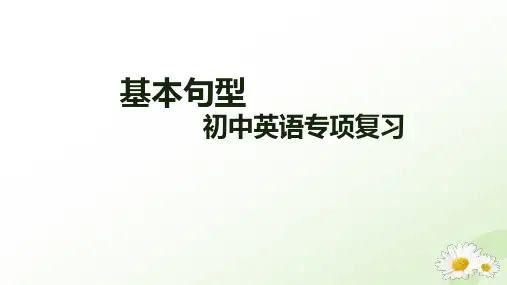
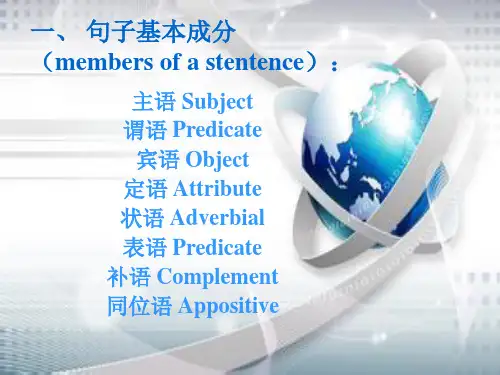
英语五大基本句型结构基本句型一:SV(主+谓)Subject(主语)+Verb(谓语)这种句型中的动词大多是不及物动词(英语中按动词后可否直接跟宾语,可把动词分成不及物动词与和及物动词。
不及物动词:字典里词后标有vi. 的就是不及物动词。
不及物动词后不能直接跟有动作的对象(即宾语)。
若要跟宾语,必须先在其后添加上某个介词,如to,of,at 后方可跟上宾语。
具体每个动词后究竟加什么介词就得联系动词短语了,如listen to,look at….),不及物动词常见的有:appear,apologize,arrive,come,die,disappear,exist,fall,happen,rise (好像还有所有的感官动词(如以上的listen——Eragon注)等等。
如:The students work very hard.学生们学习很努力。
She apologized to me again. 她再次向我道歉。
The accident happened yesterday evening.事故是昨天晚上发生的。
(happen是不及物动词,但表示“某地(某时)发生了什么事”,常用“sth.+ h appen +地点/时间”这一结构来表达,此时主语应是事情;表示“某人出了某事(常指不好的事)”,要用“sth.+ happen+to sb.”这一结构来表达——Eragon注)基本句型二:SVP(主谓表)(好像有的叫SVC(主系表)——Eragon注)Subject(主语)+Link.V(系动词)+redicate(表语)(表语是用来说明主语的身份、性质、品性、特征和状态的,表语常由名词、形容词、副词、介词短语、不定式、动词的-ing、从句来充当,它常位于系动词(be, become, appear, seem, look, sound, feel, get, smell等词)之后。
——Eragon注)这种句型中的系动词一般可分为下列两类:(1)表示状态的连系动词。